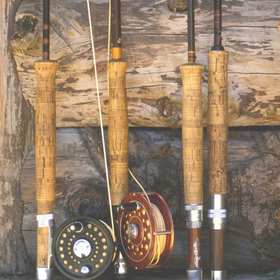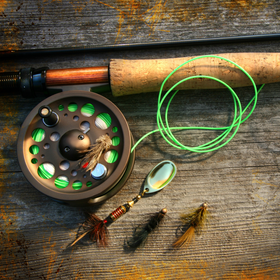Catching smallies on the fly
When talking of fly fishing, one still almost automatically thinks of trout. But, of course, fly fishing has many different forms these days, and the alternate species and forms of fly fishing get more and more popular every year. One such alternative game fish sought by fly fisher's in ever increasing numbers is the Smallmouth Bass.
While dry fly purists may scoff at the notion, of pursuing smallies on the fly rod, or even at all. To many, the Smallmouth is the epitome of fly fishing. And why not? A fish capable of spectacular aerobatics, vicious strikes, and much less reticent to take a chance on an artificial fly. Yes, if your goal in a fly fishing outing is to catch fish, that in itself is reason enough to go after smallies. Hooking 50 smallies in a day is well within the range of possibilities in many smallmouth fisheries. They are a prodigious eater, and fiercely territorial and competitive.
If you have never experienced smallmouth action before, you owe it to yourself to research smallmouth opportunities in your area. Smallmouth inhabit both rivers and lakes. River smallies can be found in hard-bottomed areas, weed beds, undercuts, and in warm water late summer conditions even in riffles. Lake smallies prefer also cooler water late in summer, but look for them in weedy areas, under structures, and other shady areas. In fact the one characteristic of smallmouths always worth remembering is they like shade. They don't care what provides it either.
Smallmouths are opportunistic feeders. Their penchant for taking surface poppers is well-known, casting out a popper that hit with a thud, and then retrieving with short abrupt strips. Creating bubbles with your popper seems to act like a calling card for smallies. Bass can also be taken on dry flies one would use for trout. In fact, incidental bass are often taken in lakes where trout and bass both live.
If surface fishing is not working bass will readily take nymphs, and streamers. One would do well to keep the old standby Woolly Buggers, well-stocked, both beaded and non-beaded in a variety of colors. The clouser minnow was first designed as a smallmouth fly, and is a reliable producer. But our all time small bass fly is the Bananarama.
As for gear, if you have trout gear, you are probably fine. Especially if just starting. It can be a bit frustrating to try to cast a popper, on 5 line or lighter however. But it can be done. Especially if you remember that the same finesse you require for casting dry flies for skittish trout, is simply not required for smallmouth. In fact you will come to recognize the 'plop' of a popper has a quality of satisfaction after awhile.
If one begins to look at the opportunities of bass fly fishing in their neighborhood, I think they will be astounded and excited at the possibilities. Often times living much closer to your work or home, they offer a quick opportunity to wet your fly. Even if they never replace your first love of fly fishing, they can enrich your fly fishing experience, and offer a quick getaway whenever time allows.
Visit our Flies by Species - Smallmouth Bass Selection




